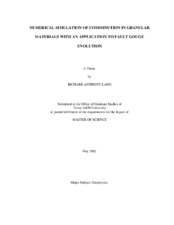| dc.contributor.advisor | Sparks, David | |
| dc.creator | Lang, Richard Anthony | |
| dc.date.accessioned | 2004-09-30T01:55:27Z | |
| dc.date.available | 2004-09-30T01:55:27Z | |
| dc.date.created | 2005-05 | |
| dc.date.issued | 2004-09-30 | |
| dc.identifier.uri | https://hdl.handle.net/1969.1/371 | |
| dc.description.abstract | The majority of faults display a layer of crushed wear material ("fault gouge") between the fault blocks, which influences the strength and stability of faults. This thesis describes the results of a numerical model used to investigate the process of comminution in a sheared granular material. The model, based on the Discrete Element Method, simulates a layer of 2-D circular grains subjected to normal stress and sheared at constant velocity. An existing code was modified to allow grains to break when subjected to stress conditions that generate sufficient internal tensile stresses. A suite of five numerical runs was performed using the same initial system of grains with sizes randomly chosen from a pre-defined Gaussian distribution. A range of confining pressures was explored from 4.5 MPa to 27.0 MPa (in case of quartz grains with average diameter of 1 mm). The average effective friction coefficients of the five simulations were relatively unaffected by comminution and displayed a constant value of about 0.26. The amount of breakage was directly related to both the applied confining pressure and logarithm of the displacement along the fault. The particle size distribution evolved during the runs, but it was apparently determined only by the cumulative number of grain breakage events: two runs with the same number of breakage events had identical particle size distributions, even if they deformed to different extents under different stress conditions. These results suggest that the knowledge of both the local displacement and stress state on a fault can be used to infer the local particle size distribution of the gouge. | en |
| dc.format.extent | 1867523 bytes | en |
| dc.format.extent | 93446 bytes | en |
| dc.format.medium | electronic | en |
| dc.format.mimetype | application/pdf | |
| dc.format.mimetype | text/plain | |
| dc.language.iso | en_US | |
| dc.publisher | Texas A&M University | |
| dc.rights | I hereby certify that, if appropriate, I have obtained and attached hereto a written permission statement from the owner(s) of each third party copyrighted matter to be included in my thesis, dissertation, or project report, allowing distribution as specified below. I certify that the version I submitted is the same as that approved by my advisory committee.
I hereby grant to Texas A&M University or its agents the non-exclusive
license to archive and make accessible, under the conditions specified below,
my thesis, dissertation, or project report in whole or in part in all forms of media, now or hereafter known. I retain all other ownership rights to the copyright of the thesis, dissertation or project report. I also retain the right to use in future works (such as articles or books) all or part of this thesis, dissertation, or project report. | en |
| dc.subject | grain breakage | en |
| dc.subject | gouge | en |
| dc.subject | comminution | en |
| dc.subject | granular media | en |
| dc.subject | distinct element method | en |
| dc.title | Numerical simulation of comminution in granular materials with an application to fault gouge evolution | en |
| dc.type | Book | en |
| dc.type | Thesis | en |
| thesis.degree.department | Geology and Geophysics | en |
| thesis.degree.discipline | Geophysics | en |
| thesis.degree.grantor | Texas
A&M University | en |
| thesis.degree.name | Master of Science | en |
| thesis.degree.level | Masters | en |
| dc.contributor.committeeMember | Hajash, Andrew | |
| dc.contributor.committeeMember | Johnson, Brann | |
| dc.contributor.committeeMember | Valko, Peter | |
| dc.type.genre | Electronic Thesis | en |
| dc.type.material | text | en |
| dc.format.digitalOrigin | born digital | en |


